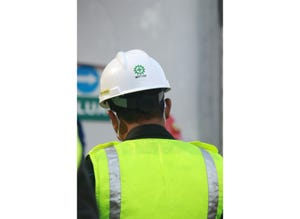Material Transfer Using Valves and Retractable Sleeves
June 5, 2012
In continuous processing material transfer methods are typically fixed operations, with mechanical and pneumatic conveying covering most applications. However batch processing of powders presents its own unique challenges especially under those circumstances where containment is critical such as transferring low-density, air-sensitive, high-value, potent, or toxic powders.
From the most benign products like sugar or flour to active pharmaceutical ingredients (API) that are extremely potent, the issues surrounding safe and effective containment and transfer are many: worker exposure to irritants, housekeeping and cleaning due to dusting, increased equipment maintenance because of contamination, poor product flow and bridging often caused by under-designed connections, and material loss from spillage are but a few of the potential material transfer problems that occur. Solutions for these issues range from a sock or sleeve that is attached to the outlet of the valve allowing product to dump under gravity into an open hopper, to split butterfly valves with a vacuum system used to keep dusting at nanogram levels.
However, for most power and bulk solids applications, an automated full port valve with a retractable sleeve is an economical and effective method of resolving these issues. Automation of the connection process, with direct status feedback, leads to more consistent and dependable material transfer while mitigating the possibility of operator error.
Combining the outlet valve with a retractable sleeve makes sense from a cost and system integration point of view. Typically a stationary flange is fixed to the outlet valve and a pneumatically operated moveable flange with a soft gasket is pushed against a flange on the receiving container which often has its own valve or cover. Sleeves and valves can be interlocked to prevent discharge of product until the sleeve is engaged. This procedure can be operated from a local control panel or tied into a plant-wide control system.
These retractable sleeves are available in telescoping rigid designs, typically of stainless steel or flexible sleeve designs, typically of white Neoprene. A wide range of sleeve materials are available such as FDA- and USDA-compliant materials, transparent sleeve material allowing operators to monitor material flow and to see when material transfer is complete, static dissipating polyurethane sleeves prevent electrical charge build up, and fabric reinforced rubbers are more robust for handling high-density and abrasive material such as metal powders.
The telescoping models are used for one-way flow and flexible models are used for bi-directional flow such as loading and unloading rotary blenders through the same port. Retractable sleeves are available in a range of sizes with a variety of stroke lengths and mounting configurations including bolt on and clamp on. Other options include connections for venting to allow for mass flow and CIP fittings for clean in place capability.
For hazardous environments where a higher level of containment is required the use of an inflatable seal on the movable flange of the retractable sleeve can achieve desired results. The seal can inflate downward against the face of a flange or outward when inserted into the neck of an intermediate bulk container (IBC).
For sanitary processes “pop in and out” sleeves are available and effective. This system is comprised of two basic elements: the flexible sleeve with integral top and bottom snap bands and two matched spigots. The fitting snaps easily into place by hand and the removal process can usually be completed by hand or with the aid of a simple tool. Eliminating hose clamps reduces the time for inspection and cleaning of sleeves.
Some sleeve materials are capable of operating in low pressure and slight negative pressure applications. These applications are commonly used in operations where the plants are drying or processing dry powdered type products and need the machinery to be under a slight negative pressure in order to keep the internals of the buildings free of dust leaking from process machinery.
Valve and retractable sleeve combinations can eliminate the need for expensive dust collector systems, increased productivity and reduced worker exposure, material loss, and cleaning and maintenance costs.
Jim Lenihan is president of Gemco Valve. He received his B.Eng. from the University of Limerick and has more than 25 years experience in the valve and seal industries.
You May Also Like


